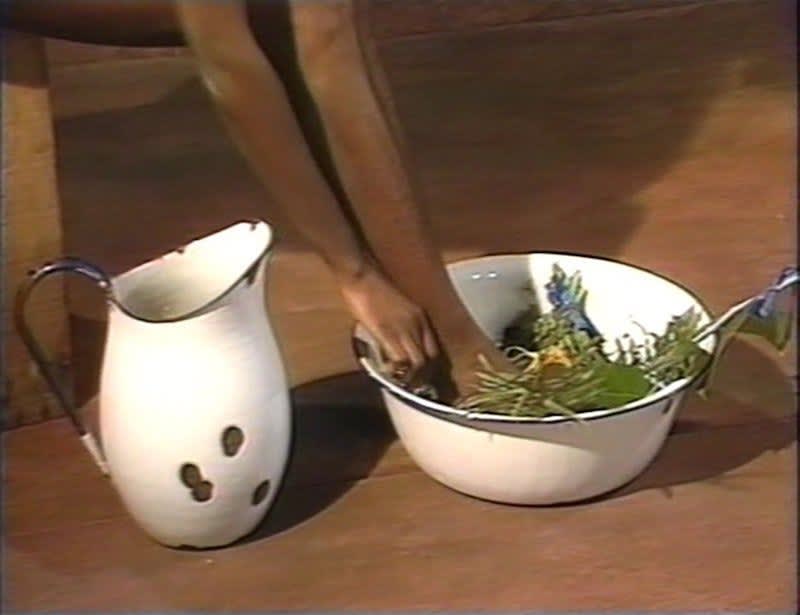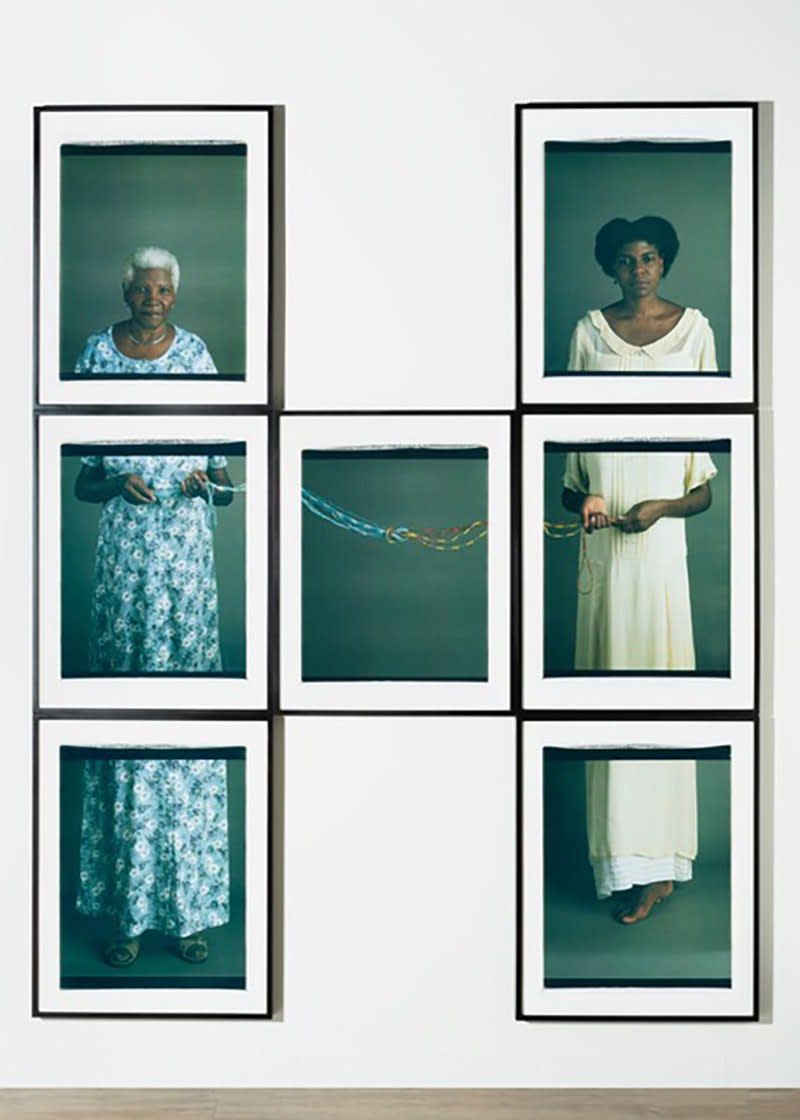María Magdalena Campos-Pons in her incarnation as her alter ego FeFa, with painted face and flowing robes, has transformed the Brooklyn Museum into a sacred precinct where Yoruba spirits walk among us. In this dark time, with few transformational rituals at our disposal, Campos-Pons as a kind of priestess comes to our aid. Our age suffers from a symbolic and spiritual bareness—the groves of the goddesses have long been felled, a crime punishable by death in the ancient world. Campos-Pons’s art is alive, embodied, and attached by an umbilical cord to her family, her ancestors, and their spirits. She reconnects us with ancient feminine mysteries, now often sadly dismissed as outdated essentialist myths. This is perhaps a meditation, more than a review, on a deeply moving exhibition, from the opening day September 16, 2023 performance (A Mother’s River of Tears) to video works, as well as the work hung in the galleries. María Magdalena Campos-Pons joins a pantheon of women artist ritualists and worshipers of the divine feminine dating back to the seventies and Heresies Journal, including fellow Cuban Ana Mendieta and Mary Beth Edelson. Campos-Pons, a descendent of enslaved African and indentured Chinese workers brought to Cuba, is an inheritor of practices which survived the dark passage in slave ships (celebrated by scholars like Robert Farris Thompson). Possessing an innate optimism and belief in the transformative power of art, Campos-Pons has brought us unique treasures in our time of desperation—and has performed much needed cleansing rituals in some of our art institutions, a practice that hopefully will be expanded.
The exhibition opens with the installation Spoken Softly with Mama (1998), a collaboration between Campos-Pons and composer Neil Leonard. Historical photographs of the Cuban women members of the artist’s family are printed onto large ironing boards while the floor is covered with glass irons and trivets. The piece is a commentary on how enslaved women were consumed by domestic duties in the service of others, leaving them little time for creativity. Judy Chicago’s Womanhouse (1972) was an earlier commentary on domestic drudgery. Spoken Softly with Mama shows Campos-Pons in a central projection folding a long column of cloth, which will be labeled with the names of the men it serves, including her father. Yet, the piece also suggests deeper mysteries and other dimensions beyond the drudgery. The portraits of the women stand like icons on the ironing boards, reverently celebrated by the artist. There is a tenderness and care to the folding, making the viewer think of the cloth woven for Yoruba kings. With the folded fabric balanced on her head, Campos-Pons stands erect with the dignity of a Caryatid bearing a canephora (basket), resembling those maidens who carried sacred objects used in feasts of Athena and Artemis. In a projected video, the artist delicately opens a pomegranate, the fruit symbolizing life and regeneration and often associated with Persephone, or in this context perhaps an offering to Oya or Shango. This fruit appears in a sacramental role in her opening performance and videos, a universal symbol of fecundity.
A single-channel 1991 video by Campos-Pons and composer Neil Leonard called Baño Sagrado (Rite of Initiation, Sacred Bath) combines Santería limpiezas and Yoruba-derived rituals of washing the feet with herbs. We can’t help but think of that other Magdalene washing Christ’s feet and drying them lovingly with her hair. The video is an homage to Yemayá, òrìṣà of the regenerative powers of motherhood and the sea, and Oshun, goddess of love, fertility, and rivers. In a world that has forgotten the energies represented by Aphrodite, here African sister deities incarnate in the art of Campos-Pons. Beauty, love, and regeneration, and tender relations are celebrated. Yemayá, goddess of the sea and Oshun, goddess of love, fertility, and rivers were the two deities given to the artist by her grandmother as guardians, and the viewer feels their presence.
Replenishing (2001), a multi-paneled portrait of the artist and her mother, celebrates Oshun and Yemayá using the color of the two women’s dresses. They are connected by a cord of beads called collares. Made after the artist’s eleven-year absence from Cuba, it symbolizes their shared spiritual and physical connection in a way that seems alive and heartfelt. Another multi-panel work, Umbilical Cord (1991), was made during this extended absence. The artist asked her friend Ramón Pacheco to photograph her female family members in her hometown of Matanzas. They are connected with an umbilical cord made of wire, fabric, and soil from Cuba. De las dos aguas (Of the Two Waters) (2007) reintroduces Oshun and Yemayá, again in their respective colors, connected by strands of hair and a suspended boat symbolizing migration both forced and voluntary. Bags stamped “this is not art” suggest those things which are beyond the capacity of art. The spirits have a life of their own.
This is a highly complex exhibition by an artist who inhabits many spheres: the spirit world, the American South, Cuba, and the international art world. An excellent catalogue with essays by Carmen Hermo, Jenée-Daria Strand, and Mazie M. Harris explores the artist’s Cuban roots, videos, and complex artistic practice. This meditation has focused on her connection to her ancestral spirits who inhabit the artist as living presences. With her lived connections to her ancestral lineage and Yoruba nature spirits, Campos-Pons guides us into a world where beauty and love of living things are celebrated. She shows us that all humanity, regardless of time, gender, or race, can access these powers. Campos-Pons brings peace, connection, and beauty into embattled art institutions that can feel starved of spirit, in a way that hopefully signals a needed update. Campos-Pons has presented us with a treasure trove not to be missed.





